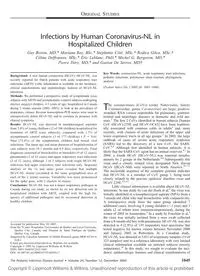
2005 Infections by Human Coronavirus-NL in Hospitalized Children PDF
Preview 2005 Infections by Human Coronavirus-NL in Hospitalized Children
ORIGINAL STUDIES Infections by Human Coronavirus-NL in Hospitalized Children Guy Boivin, MD,* Mariana Baz, BSc,* Ste´phanie Coˆte´, MSc,* Rodica Gilca, MSc,† Ce´line Deffrasnes, MSc,* E´ric Leblanc, PhD,* Michel G. Bergeron, MD,* Pierre De´ry, MD,* and Gaston De Serres, MD† Background: A new human coronavirus (HCoV), HCoV-NL, was recently reported for Dutch patients with acute respiratory tract infections (ARTI). Little information is available on the incidence, clinical manifestations and epidemiologic features of HCoV-NL infections. Methods: We performed a prospective study of symptomatic (case subjects with ARTI) and asymptomatic (control subjects undergoing elective surgery) children, �3 years of age, hospitalized in Canada during 2 winter seasons (2001–2003), to look at the prevalence of respiratory viruses. Reverse transcription-PCR assays were used to retrospectively detect HCoV-NL and to correlate its presence with clinical symptoms. Results: HCoV-NL was detected in nasopharyngeal aspirates from 3.0% of young children (12 of 396 children) hospitalized for treatment of ARTI (case subjects), compared with 1.7% of asymptomatic control subjects (3 of 177 children) ( P � 0.6). Nine (75.0%) of the symptomatic children had mixed viral infections. The mean age and mean duration of hospitalization of case subjects were 10.1 months and 4.9 days, respectively. Final diagnoses consisted of bronchiolitis or bronchitis (9 of 12 cases), pneumonitis (1 of 12 cases) and upper respiratory tract infections (2 of 12 cases), although 2 of 3 subjects with single HCoV-NL infections had upper respiratory tract infections only. Sequence analysis of the 1a and spike genes revealed that multiple HCoV-NL strains circulated in the same geographical area in each of the 2 winter seasons. Variability was more pronounced for the spike gene, with 2 clusters of strains. Conclusions: HCoV-NL was not a major respiratory pathogen in Canada during our study, as shown by its low detection rate in hospitalized children with ARTI, coupled with the high fre- quency of additional pathogens and its occasional detection in healthy children. Key Words: coronavirus-NL, acute respiratory tract infections, pediatric infections, polymerase chain reaction, phylogenetic analysis (Pediatr Infect Dis J 2005;24: 1045–1048) T he coronaviruses (CoVs) (order Nidovirales, family Coronaviridae, genus Coronavirus) are large, positive- stranded, RNA viruses responsible for pulmonary, gastroin- testinal and neurologic diseases in domestic and wild ani- mals.1 The first 2 CoVs identified in human subjects �human CoV (HCoV)-229E and HCoV-OC43� have been tradition- ally associated with common colds in adults2 and, more recently, with clusters of acute infections of the upper and lower respiratory tracts in all age groups.3 In 2003, the large outbreak of cases of severe acute respiratory syndrome (SARS) led to the discovery of a new CoV, the SARS- CoV.4,5 Although first identified in human subjects, it is likely that the SARS-CoV agent has an animal reservoir.6,7 In 2004, a fourth HCoV (HCoV-NL) was reported simulta- neously by 2 groups in the Netherlands.8,9 Subsequently this virus and a closely related virus designated New Haven HCoV (HCoV-NH) were reported in North America.10–12 The nucleotide sequence of the complete genome indicates that HCoV-NL is a member of CoV group 1, being most closely related to the porcine epidemic diarrhea virus and HCoV-229E.8,9,13 Little clinical information is available about HCoV-NL infections. In one study by van der Hoek et al,8 the virus was initially identified in a nasopharyngeal aspirate (NPA) from a 7-month-old child who had bronchiolitis with conjunctivitis. A retrospective study from the same group identified 7 additional cases, involving 4 young children (�1 year) and 3 adults (2 of whom were immunocompromised), during the winter of 2003 in Amsterdam.8 In a study by Fouchier et al,9 the virus was initially isolated from a nose swab collected from a 8-month-old boy with pneumonia. HCoV-NL was also detected in 4 (2.9%) of 139 respiratory tract specimens that tested negative for known viruses between November 2000 and January 2002 in Rotterdam. In a Canadian study, HCoV-NL was detected in 3.6% of respiratory samples (19 of 525 samples) sent to a reference laboratory with very limited clinical information available on infected subjects (mostly outpatients).10 In this study, we sought to evaluate the inci- dence, epidemiologic features and clinical manifestations of Accepted for publication May 10, 2005. From the *Centre Hospitalier Universitaire de Que´bec and Laval University, Quebec City, Canada; and †Institut de Sante´ Publique du Que´bec, Quebec City, Canada Supported by Canadian Institutes of Health Research (grant MOP-62789 to G.B.). E-mail
